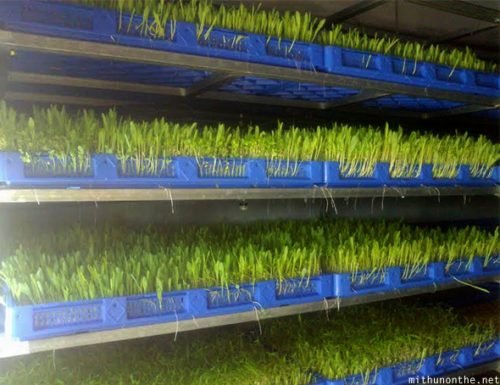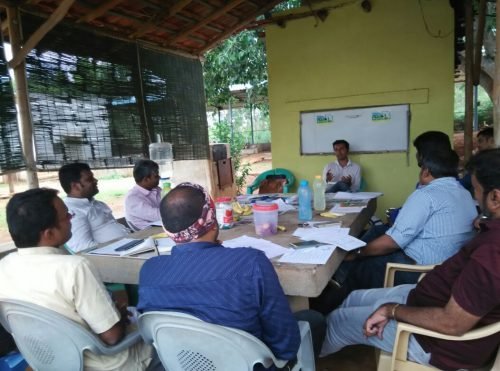The Complete Guide to Becoming an ‘Urban Dairy Farmer’ Without Quitting Your Job
Few days ago, my friend who works in Cognizant called me. She was worried about the fact that her company was laying off almost 6,000 employees at once. Though she was far from figuring in this scary list, she could still feel the uncertainty of being in IT after this.
Another friend had to rent out her own house and shift to a rented one herself, as she was tired of the two-hour commute, including the one hour of just being held up in traffic every single day.
We all want to come out of this trap called the ‘city life’. We know the long lasting ill effects of breathing the polluted air or eating vegetables grown using harmful pesticides or having adulterated versions of almost everything that’s supposed to be healthy. But we don’t! And how would we… it is not as easy as it seems… isn’t it?
Santhosh Singh had a similar dilemma when he was working in Dell as an Analytics Advisor.
Santhosh Singh
A hefty pay and a luxurious life was not giving him what he would get over a weekend of just staying in the arms of nature – Peace and Health.
“I loved to spend most of my weekends in nature. I would go camping, away from the city and always wished if I could stay there forever,” says Santhosh.
Like thousands of other IT professionals, he would get back to work every Monday and spend money on things he says were of no value to him in the long run.
“When I was in the corporate world I did most of the things because someone else was doing it. I would end up shopping or doing things just by aping others, which had no value for me,” he says.
Santhosh kept thinking about life spent nearer to nature, but the only question was of sustainability. He realized that he has to create a simple support system mechanism to earn a living as well as enjoy nature.
“To love something and to know if you can actually do it or not are two different things. I wanted to know if I can actually enjoy agriculture and so I started spending time with farmers and learning more about farming,” Santhosh says.
In June 2009, Santhosh finally quit his well paying job and decided to get into dairy farming, which, according to him, was the most feasible option.
Santhosh quit his job and started experimenting with just 3 cows.
“I decided to get into dairy farming, as this was a relatively stable and profitable business in the unpredictable world that is Indian agriculture,” he says.
You may also like – Delhi’s Shahbad Dairy Is Witnessing a Unique Drive for Education. And It’s Led by a 14-Year-Old!
Instead of starting off immediately, he took a break of few months and visited more farms. He then bought three cows and started his project. But he soon realized that there were lots of things he was still unaware of. He tried taking help from traditional farmers, but his confusion only increased.
“Different farmers gave different advice. Some would say you should feed the cow before milking and some would ask to feed after milking. They also had different opinions on the type of feed to be given to the cattle,” explains Santhosh.
It was then that Santhosh thought of seeking professional help. He attended workshops conducted by National Dairy Research Institute (NDRI) in Bengaluru. The training helped him get his basics right about dairy farming. Santhosh was now confident to take up the 20-cow model dairy farming.
He started his farm, and called it ‘Amrutha Dairy Farms’, 40 km from Bengaluru in his 3-acre ancestral land in Doddabalapur.
Amrutha Dairy Farm
With the learning gained from NDRI, and support from one of his brothers, Santhosh handled the farm really well and bought 85 cows in the next two years.
However the coming year was a challenge for them as their village suffered from a severe water crisis. Water levels, which were around 200 ft, reached up to 1,000 ft, and Santhosh had to put in all his savings to deal with this situation. But this crisis led Santhosh to hunt for options.
Research led him to a surprising fact — dairy farming is not just about cows and milk. There are businesses related to dairy farming like selling fodder, transportation of milk, processing, selling cow-comforts like rubber mats and cubicles, selling medicines for the cattle, and the most profitable one –breeding of cattle.
So Santhosh started breeding cows and selling them once they started milking.
“We buy 3- to 6-month-old calves, raise them for a year and a half, and then sell to commercial dairy farms in South India. We have a batch of 60-120 calves that are sold to new farms after two years,” he informs.
He also set up the first production unit of hydroponics, which enables growing of 1 tonne of green fodder per day in a controlled environment, serving as backup just in case the rains are a no-show.
Hydroponics is a method of growing plants using mineral nutrient solutions, in water, without soil. They have such a facility in the farm.
Meanwhile, a German company wanted to set up its processing unit in India. Santhosh offered his space for this and provided local consulting support, and during this period, learnt a little bit of cheese processing.
He slowly started to understand the whole value chain of the Dairy Industry and realized great opportunities that exist currently. Visitors started coming to his farm and he would enjoy meeting and interacting with them. And then came the idea of training and counseling the budding entrepreneurs.
From the past two-and-a -half years Santhosh is conducting workshops on two Saturdays of every month.
You may also like – Two Men from the US Are Helping Dairy Farmers in Rural India Keep Milk Chilled without Electricity
So far, he has trained 600 professionals to take up dairy farming in over 95 workshops held in more than 12 states of the country.
He has also helped setup over half a dozen dairy farms for his trainees who have hired him as consultant.
“We share everything that we have learned in the past seven years. This gives them a picture of what they can expect on the other side of their decision. The ‘One-Day Training’ that we conduct is the shortest format of Dairy Training that exists in the country. It is very encouraging to see sometimes CEOs, MDs and even senior citizens attending the one-day workshop. The training gives a 360 degree overview on commercial dairy farming practices. One can do a pilot project without quitting their job; something that doesn’t hurt their pocket or family or lifestyle,” Santhosh said while talking to TBI from his farm.
“Only 3% to 5% of people who attended the workshops took up dairy farming. Over 50% had complete clarity right after the workshop that it may not work out for them. Either they cannot do it or they don’t have the resources to do it,” he adds.
Santhosh has developed a business model for those who want to start a pilot project and try dairy farming before they actually quit their regular jobs and go for it full time.
He calls it ‘the Urban Dairy Farmer’s model’ –
Capital required for the pilot project – Rs. 6 lakh
You need to buy – 5 cows (pregnant for first time) plus 5 calves
Land required – 1 -2 acres (you can also take on lease if you don’t own it)
Labour required – 2 (preferably a farmer couple)
Cost of 5 cows – Approximately Rs. 3 lakh
Cost of raising 5 calves for 2years – Approximately Rs. 1.5 lakh(crossbred HF calves becomes cows in 2 years)
Cost of infrastructure like cattle shed and labour house – Rs. 1.5 lakh
In two years, the herd count becomes 10 cows plus six to eight female calves. The income generated from five cows can be used to pay just the salary of one farmer family, who manage the farm in cases where milk is being sold directly to unions.
In case the promoter decides to directly sell the milk to consumers, the income generated could be used to pay the loans and EMIs, apart from salary paid to the farmer family as consumers pay a little extra when compared to milk unions. This way, in three years most of the loans availed would be cleared and the promoter would have a total of 12 cows and 10 calves,which could be valued at Rs. 5 lakh-6 lakh.
In today’s scenario, if one has 10 cows, selling milk directly to consumers at a price of Rs.40-50 per litre can rake in about Rs. 30, 000 to Rs. 40,000 a month.
This way, one can continue their day job and try out remote management and learn for a few years before deciding to go into it full time.
There is subsidy provided by NABARD, it is called as Dairy Entrepreneur Development Scheme (DEDS), here 25% subsidy is provided if a person takes Rs. 6lakh loan from the bank. Most of the banks provide loans for this and also help people avail subsidy from NABARD.
“The promoter has to bring in just Rs.60, 000 (10% margin money for Rs 6 lakh) and bank will fund the rest of the amount as a loan, which is about Rs 3.9 lakh apart from the Rs 1.5 lakh subsidy. So why take that big decision of quitting completely what you are doing in haste and end up with more problems when you can try the pilot project and learn while you earn,” suggests Santhosh.
You may also like – 7 Fabulous Farmstays in India That Allow You to Learn Organic Farming While Vacationing!
When asked about what traditional farmers sometimes overlook, he says, “Farmers generally treat livestock as a non-essential commodity of their livelihood. The cattle get green fodder only when it rains and rest of the time they are fed with dry fodder. Whereas they can increase productivity by 20%, just by feeding silage (preserved green fodder) all year round.”
Santhosh also suggests taking extra care of the hygiene of cows’ udder, which are sensitive and get infected, sometimes infecting the milk.
Amrutha dairy farm is in the process of building more infrastructure so they can accommodate trainees for a week’s program where they can stay and experience the life of a farmer.
You can visit Amrutha Dairy Farms at –
Halenahalli, Madhure Hobli, Doddabalapur TQ, Bengaluru, Karnataka
If you wish to attend Santhosh’s workshop then you can mail him at [email protected] or call him at 098451 90600




Congratulations @rapsworld! You received a personal award!
You can view your badges on your Steem Board and compare to others on the Steem Ranking
Vote for @Steemitboard as a witness to get one more award and increased upvotes!